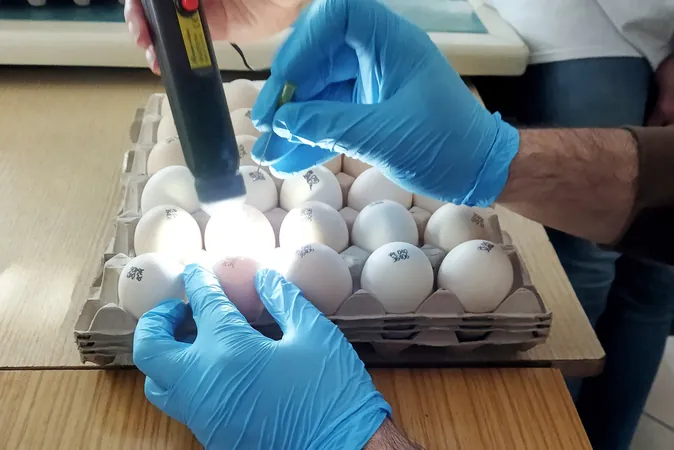
The Untapped Power of Lactic Acid Bacteria: A Game Changer in Livestock Health
2024-12-30
Author: Emma
Introduction
In a world increasingly resistant to antibiotics, the role of lactic acid bacteria (LAB) has emerged as a beacon of hope. These tiny warriors not only combat pathogens in livestock but also enhance animal welfare and performance. With the scrutiny around antibiotic use becoming more rigorous, LAB offers a natural alternative that is garnering significant attention.
Research and Discoveries
For years, researchers like Dr. Maria Siwek from the University of Technology and Life Sciences in Bydgoszcz, Poland, have been delving into the remarkable capabilities of LAB. Along with her team at the Teagasc Food Research Centre in Ireland, she recently highlighted their potential to combat poultry pathogens—a finding poised to revolutionize livestock farming practices.
The Science Behind LAB
LAB are not just ordinary bacteria; they are a diverse group producing lactic acid and other organic acids such as acetic, formic, butyric, and citric acids. These compounds create an unfavorable environment for many pathogens, disrupting their ability to replicate and synthesize proteins. Understanding the varying sensitivities of pathogens to these acids is crucial for optimizing LAB's effectiveness.
The Bacteriocin Advantage
Beyond organic acids, some LAB strains secrete powerful peptides known as bacteriocins. These natural antimicrobials operate through various mechanisms, such as rupturing cell walls or creating pores in pathogen membranes. Some LAB strains also produce hydrogen peroxide, which can further deter microbial growth, creating a comprehensive defense against a wide range of pathogens.
What sets LAB apart from other non-antibiotic control agents, including phytobiotics, prebiotics, and essential oils, is their ability to proliferate within the body. Once ingested, these bacteria multiply in the small intestine, continuously working to produce beneficial metabolites that support animal health, digestion, and overall wellbeing.
Addressing Challenges
However, the rise of LAB is not without its challenges. There remains a looming threat that pathogens could develop resistance to LAB’s natural antimicrobial properties. Additionally, LAB may absorb resistance genes from pathogens due to microbial DNA transfer, raising caution among researchers and veterinarians. Continuous research and vigilant monitoring are essential to mitigate these risks.
The Market for LAB Products
A plethora of LAB products is available to livestock producers, including popular formulations like FloraZone, Lavipan, PoultryStar, and Probiotics Daily, which often combine LAB with other beneficial organisms and compounds like β-Glucan. Dr. Siwek emphasizes the importance of adhering to strict manufacturing protocols to guarantee these products do not endanger livestock health.
It's not just about ensuring the efficacy of LAB; companies must also ascertain that the LAB strains they utilize withstand stomach acid and bile and reach the small intestine alive. This is typically achieved through methods such as encapsulation.
Moreover, as the landscape of livestock production evolves, evaluations should be conducted to confirm that these LABs do not disrupt the natural diversity of an animal's gut microbiome. In light of the potential for gene transfer, monitoring for antibiotic resistance genes among LAB strains will be vital.
A Breakthrough in Poultry Farming
Dr. Siwek's compelling research on LAB in poultry has shown promising results. Her recent studies involve a LAB strain called *Leuconostoc mesenteroides*, tested in broiler chicken eggs. The combination of this strain with garlic extract significantly reduced the presence of *Campylobacter jejuni*, a notorious pathogen, in the gastrointestinal system of chicks.
As the industry moves forward, researchers are keen to explore how different LAB strains affect various livestock species and their breeds. The EU-funded project “MonoGutHealth” aims to understand how LAB can potentially modulate the gut microbiome in both healthy and pathogen-infected scenarios, enhancing animal resilience and health.
Conclusion
The findings surrounding LAB are not just a short-lived trend; they represent a turning point in sustainable livestock farming. As researchers unlock the secrets of these beneficial bacteria, we might witness a future where the reliance on antibiotics is dramatically reduced, ensuring healthier livestock and safer food for everyone.



 Brasil (PT)
Brasil (PT)
 Canada (EN)
Canada (EN)
 Chile (ES)
Chile (ES)
 Česko (CS)
Česko (CS)
 대한민국 (KO)
대한민국 (KO)
 España (ES)
España (ES)
 France (FR)
France (FR)
 Hong Kong (EN)
Hong Kong (EN)
 Italia (IT)
Italia (IT)
 日本 (JA)
日本 (JA)
 Magyarország (HU)
Magyarország (HU)
 Norge (NO)
Norge (NO)
 Polska (PL)
Polska (PL)
 Schweiz (DE)
Schweiz (DE)
 Singapore (EN)
Singapore (EN)
 Sverige (SV)
Sverige (SV)
 Suomi (FI)
Suomi (FI)
 Türkiye (TR)
Türkiye (TR)
 الإمارات العربية المتحدة (AR)
الإمارات العربية المتحدة (AR)